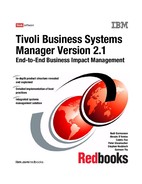4 Tivoli Business Systems Manager Version 2.1: End-to-End Business Impact Management
1.1 Business systems management
Over the past 20 years we have seen a dramatic increase in complexity in the
variety of computer systems and software used to run a business. Gone are the
days when a computer system was isolated and used for the single purpose of
word processing or producing a spreadsheet. Now we have multiple systems,
such as a cluster of database servers, providing a single service, or multiple
services provided by a single machine such as a mainframe.
Most often, these computers are all networked to form a single, very complex
enterprise. The IT departments that maintain these computers specialize in such
infrastructures and have an extensive understanding of how these machines
work and how to fix the technology when it breaks.
However, as the environment becomes more complex, business users also want
to understand the health of the infrastructure and the IT environment for their
particular functions. Each sector of the business may have its own opinion about
which machines or resources are most important. All need to understand the
state of their operation so they can proactively manage their resources.
The IT department may understand that all resources are important, but most
likely would not know the overall impact of each of these resources in the
business sense. When multiple resources fail at one time, they may need to
prioritize repairs, which means understanding the impact of each single resource
on the enterprise’s operations.
These requirements from both the business and the IT department can be
addressed together: Business users can see the resources that they are using
and how they affect their function, and IT personnel can use a reversed model to
see which function from the business user is affected by the resources.
To be able to perform this function, the system must coordinate and collect the
status of all IT resources from the different parts of the enterprise using various
systems management tools. It also must be able to make an abstraction of the
entire business structure that incorporates the IT resources. It also needs
interfaces to other parts of the business, such as problem and change
management.
We will see how these business and IT needs can be met.
..................Content has been hidden....................
You can't read the all page of ebook, please click here login for view all page.
